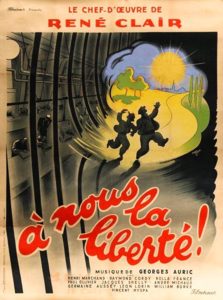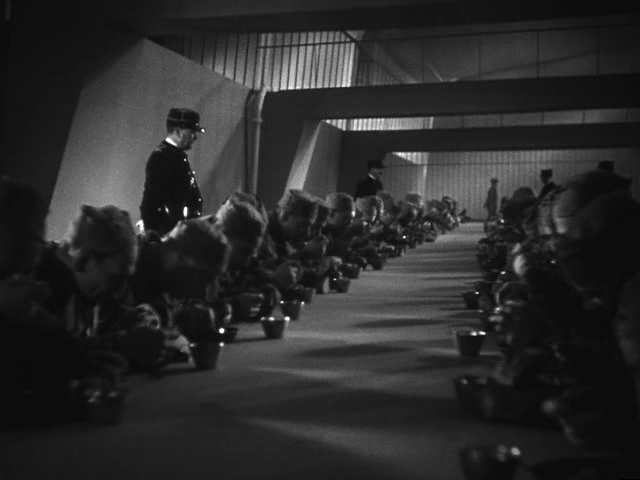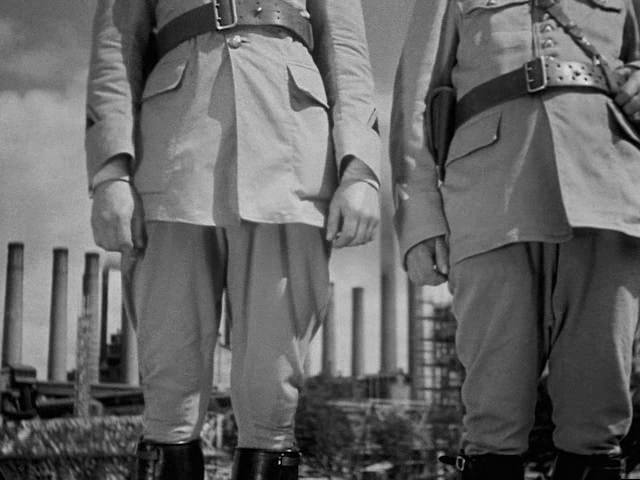“In life, liberty is all that counts.”
|

Synopsis:
A convict (Raymond Cordy) escapes prison with the help of his buddy (Henri Marchand) and quickly establishes himself as a phonograph factory magnate. Once Marchand catches up with Cordy, he falls in love with a beautiful secretary (Rolla France) at the factory, hoping to win her heart.
|
|
Genres, Themes, Actors, and Directors:
- Class Relations
- Ex-Cons
- French Films
- Musicals
- Rene Clair Films
Review:
Rene Clair’s follow-up to Le Million (1931) was this playful musical showing how industrialized work in the early 20th century mimicked the anti-human drudgery of prison. Meanwhile, as convicts become capitalists, class relations are effectively skewered, and we learn that true happiness comes from freedom rather than commitment to wealth, societal norms, responsibility, or romantic love. In addition to its innovative use of sound and stylized sets, this film is primarily notable for the fact that some of the factory sequences very closely resemble similar scenes in Modern Times (1936); indeed, without Clair’s approval, the production company sued Chaplin. The storyline unfortunately doesn’t give us much to hold onto — we know that Marchand’s love interest has another suitor, and thus he’ll never win her authentic affections; the primary tension comes from wondering how the bowler-hatted Cordy will treat Marchand once their fortunes have shifted. Is there loyalty among (ex)thieves?
Redeeming Qualities and Moments:
- Effectively stylized sets (by Lazare Meerson) and cinematography



- Georges Auric’s score
Must See?
Yes, for historical purposes.
Categories
(Listed in 1001 Movies You Must See Before You Die)
Links:
|
One thought on “A Nous la Liberte (1931)”
First viewing. A once-must – for its place in cinema history, Clair’s direction and the performances by Marchand and Cordy.
Having just watched both this and ‘Le million’… I’ll confess that while I find ‘Le million’ more enjoyable (probably for its simplicity), I think ‘À nous la liberté’ is a better film (for its complications mostly). That said, film fanatics should see both; they’re marvelous examples of the director at his best.
One of this film’s main assets is its two stars. Unlike with ‘Le million’, here we have two performers who stand out as actors and are particularly memorable as we are watching them; they aren’t subservient to the story, they drive it. Our interest in them is maintained and that anchors viewers as the plot zigzags in directions that the much-less-ambitious ‘Le million’ does not. They’re both wonderfully expressive.
The stylized look – as is true of ‘Le million’ to a lesser degree – seems to owe much to German expressionism, with its use of shadows and sharp, threatening angles.
~which brings us to the questions of influence and inspiration, esp. with regard to the lawsuit Clair’s distribution company (much against his wishes, since he was a great admirer of Chaplin) filed against Chaplin: a suit that went on for a few decades. A DVD extra goes into complete detail on the case – which was eventually dropped with a settlement. From Clair’s stated viewpoint, he believed Chaplin had seen his film (something Chaplin denied) but he took the high road in pointing out that he himself had often been influenced by Chaplin in his work and that imitation was the highest form of flattery. (It’s been too long since I’ve seen ‘Modern Times’; I’ll have to rewatch it to see just how similar the two films might be.)